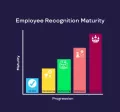
The Power of Peer Recognition: Fostering a Culture of Appreciation
August 23, 2023
Discover how peer recognition benefits organizations and employees alike. Learn how to successfully implement peer recognition for a happier workplace.
Even in organizations that do employee rewards and recognitions really well, the value of peer recognition is often overlooked—or at least underestimated. In many cases, workplace recognition from one’s peers can be just as important as recognition from managers and team leaders. In all cases, organizations that encourage and facilitate peer recognition can use this strategy to foster a culture of employee appreciation in the workplace.
Peer recognition is not limited to celebrating success. Employees can benefit from having peers recognize and acknowledge their efforts and their roles regardless of outcomes, which may be out of an individual’s control. In organizations with a strong recognition culture, employees receive messages of appreciation for what they bring to the table.
Peer-to-peer recognition matters as much as top-down recognition for a variety of reasons. When employees recognize one another for their contributions, bonds among teammates strengthen and the day-to-day experiences of employees can be transformed. Peer recognition can be a primary driver of inclusion and belonging, can lead to higher levels of employee motivation and engagement, and even improve communication.
Understanding Peer Recognition
Peer recognition isn’t confined to simply showing gratitude for a person’s actions. It can take a variety of forms, such as verbal vs. written and public vs. private. Ideally, finding out how each employee likes to receive recognition and following those wishes is central to an effective peer recognition program and practice. If, for instance, someone is strongly introverted and deeply uncomfortable with group attention, it might be preferable for that person not to have their name called out during a team meeting. Instead, they might genuinely appreciate a one-to-one conversation.
Employees can recognize one another by acknowledging special dates and life events, such as a wedding anniversary, new home purchase, or even zeroing out one’s student loan balance. Consider asking employees to identify the special dates and events they want to share with their peers, and creating a shared calendar that everyone can add to. This way, every employee can decide what they are comfortable sharing, while gaining visibility into the important dates their peers have shared.
Of course, employees could simply email or instant message their peers to recognize events and contributions. But when organizations facilitate peer recognition as part of a broader employee recognition program—especially on a platform like Connects—it becomes a more organic part of the employee experience.
Building a Culture of Peer Recognition
Peer recognition doesn’t happen in a vacuum, nor does it become a baked-in part of workplace culture without leadership forging the way and setting an example. After all, peer recognition is a natural extension of team recognition as well as an important aspect of employee recognition programs.
When leaders provide positive feedback and employees witness them consistently providing encouragement, it becomes more comfortable for employees to communicate in similar ways with their peers. Leaders who prioritize fostering gratitude among their teams might be more likely to reap the benefits of peer recognition.
In addition to demonstrating employee recognition, leaders must also set clear goals and expectations for recognition. Sharing with a team about the benefits of peer recognition and how it ties into the organization’s values and mission can be helpful—as can rewarding those who embrace the practice of peer recognition.
Best Practices for Implementing Peer Recognition
In order to get peer recognition right—and ensure it contributes to a culture of appreciation—it’s crucial for employees and managers to receive training and education on the organization’s peer recognition program. Helping employees in every role understand the company’s commitment to rewards and recognition serves to reinforce expectations.
Some key best practices around peer recognition include:
- Regular evaluation and feedback on the recognition system with opportunities for frequent, timely recognition
- Incorporating peer recognition into performance reviews
- Ensuring inclusivity and fairness in the recognition process
- Using technology to facilitate peer recognition (more on this below)
The Role of Peer Recognition in Employee Engagement
As we mentioned earlier, peer recognition contributes to inclusion and belonging, and strengthens bonds between team members that can lead to better communication and collaboration. All of this is possible because, when peer recognition functions as part of a larger culture of appreciation, employees can be more likely to feel higher levels of trust in one another. Add all these components together and we have a recipe for higher employee engagement—which is historically linked with higher levels of innovation, reduced turnover, and higher employee satisfaction.
Peer Recognition Platforms and Programs
Peer recognition doesn’t technically require special software or platforms—but organizations can get a lot more out of it with the right tools in place. When leveraged as part of an employee recognition platform, leaders can consistently encourage and facilitate peer recognition (leading to higher adoption rates) and glean insights from the use of data and analytics (which can be used to further improve employee recognition programs).
Having the ability to measure the impact of peer recognition may also help leaders hone in on employee engagement and workplace culture goals—crucially important for organizations seeking to recover from a toxic culture.
Using the right tools for peer recognition can also bridge the divide between in-person and remote workers—with virtual recognition—which further strengthens organizational culture and provides more consistency in the employee experience, regardless of work location.
Conclusion
Peer recognition matters from an organizational perspective because it can lead to higher levels of employee engagement, more (and more effective) communication and collaboration, and reduced costs by way of reduced turnover. To employees, peer recognition is important because it fosters feelings of inclusion and belonging, improves trust, and can help people feel happier with their work and their teams. While implementing peer recognition takes time, it’s a worthy investment for any organization seeking to improve business outcomes, workplace culture, and the employee experience.




